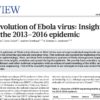The 2013-2016 Ebola epidemic in West Africa was of unprecedented size and devastation, but also stands a landmark for infectious disease genomics. By sequencing virus genomes directly from patient samples, scientists are now able to investigate how viruses evolve, transmit between individuals, and spread across country borders during outbreaks, directly informing infection control. While next-generation sequencing (NGS) has enabled the transformation of much more accurate and fine-scaled epidemiological investigations and infectious disease surveillance, there has also been a lot of confusion about data interpretations and their limitations.
In a Review published in Nature, we describe in detail the findings of the many genomic studies published during the 2013-2016 Ebola epidemic. We put particular focus on some of the main misunderstandings and limitations of NGS virus surveillance data, and describe how infectious disease genomics will play a key role in future outbreak response.
Links:
Review in Nature











